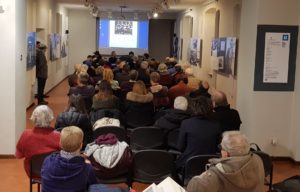FEATURES Trieste, a City of Borders
Jewish history is not a mere sub-field, but an indispensible aspect of European history, and this traveling exhibition recognizes their role. From February 27th to March 29th, 2018, one hundred years after the end of the First World War, the “Carlo and Vera Wagner” Jewish Museum of Trieste featured the exhibition: “Austro-Hungarian Jewish Soldiers on the Isonzo Front.” As described by the online blog “Triest ebraica,” visitors were able to experience the life of these men “through vintage photos, historical maps, laws and regulations of the Empire, testimonies and diaries.”
The exhibition consisted of 15 panels and a bulletin board that displays objects of the Jewish Austro-Hungarian soldiers. Initially, the texts of the soldiers were in Slovenian, Hebrew and English, but they have been translated into Italian. Additionally, a montage of photographs portraying Jews in the various armies involved in the Isonzo Front are projected.
Together, with the Study Center for National Reconciliation in Ljubljana and the Maribor Synagogue Cultural Center, this exhibit was established in 2011 by the “Milko Kos” Institute of History. The editors were Renato Podbersič and Petra Svoljšak, and it is in memory of the late Filip Fischer z’l Community member, who was the first to draft the idea of the exhibition. Before Trieste, the exhibit was also presented in 2014 at the Jewish Museum of Gorizia, organized by the Italy-Israel Association.
Since the official establishment of Trieste’s Jewish Community in 1746, members have promulgated the cultural and religious aspects of their history. Therefore, the Jewish Museum has become a centerpiece of their rich history. Along with this exhibit, the museum’s collection is “composed of silver, fabrics, documents, and books that record both the public and familial dimensions of Jewish life.” Past visitors have commented that the Museum is “a little jewel” and a “real eye-opener” to the history of Trieste’s Jewish community.
Back in 2014, a few members of the community who were interested Podbersič and Svoljšak’s exhibit had ventured to Gorizia’s Jewish Museum where it was on display at the time. However, on the inauguration day of the exhibit in Trieste, the museum was packed. “In spite of there being a greater number of those who chose to fight for Italy, the Community has welcomed it very well, for several reasons,” explains the “Carlo and Vera Wagner” Museum. “There are some who are descendants of the Jews who had fought in the Austro-Hungarian army, and this reconstruction fills a gap, a sort of oblivion, that for decades has affected the Jews of Trieste who had fought on that side of the Isonzo Front.”
The correspondents at the Museum continued: “The Jewish presence in the Italian army has always been emphasized, partly because some of the Jews from Trieste were awarded for military valor. It is therefore important to recover the history and memory of the Jews who fought in the Hapsburg ranks, not in the optics of opposing nationalisms, but to understand all of the conflicting parties and to avoid the traps of rhetoric.”
The curious position of Triestine Jews, some of whom chose to fight for Austria-Hungary and others for Italy, is due to the fact that Trieste was not part of Italy at the time, but rather, part of the Austro-Hungarian Empire. However, the Jews of Trieste tended to be Italian-speaking and many of them were pro-Italy. This led many of them to side with Italy in the war. It was only after World War I and the dissolution of the Austro-Hungarian Empire, that Trieste became a part of Italy.
The Jewish Community of Trieste now gives the public a chance to revisit these events through the lens of Jewish soldiers. Their memories have lived on through photographs and their personal daily accounts recorded in their journals. Some 300,000 Jews served in the Austro-Hungarian army, making up 3% of the nine million men mobilized by the Hapsburgs between 1914 and 1918. The horrific battles along the Isonzo front (between Italy and Austria-Hungary) resulted in mass casualty: at a death count of 300,000, the Italians lost nearly half of their army, while the Austro-Hungarians suffered 200,000 losses, 40,000 of whom were Jews.
By visiting this exhibition this spring at the “Carlo and Vera Wagner” Jewish Museum, visitors came to understand how the soldiers’ faith and vitality allowed them to survive such a gruesome, protracted battle.
*Giulia Nicolai is a student at Muhlenberg College (Allentown, Pennsylvania, USA).

